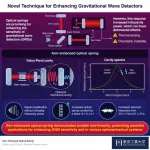(Press-News.org) Researchers at The University of Texas MD Anderson Cancer Center showed that altering the sequence of breast cancer treatment to administer radiation before mastectomy allowed for concurrent breast reconstruction surgery, which reduced the number of operations required, minimized treatment delays and improved patient satisfaction.
The Phase II trial results, published today in JAMA Network Open, evaluated 49 patients who received radiation therapy followed by mastectomy with immediate breast reconstruction. There were no complete flap losses or disease recurrences at a median of 29.7 months of follow-up.
“Our trial represents a pioneering achievement in the U.S., demonstrating the safety and effectiveness of this paradigm-shifting treatment sequence for patients with breast cancer,” said lead author Mark Schaverien, M.D., associate professor of Plastic Surgery. “This sequence not only enhances surgical outcomes but also eliminates the need for patients to defer breast reconstruction surgery, significantly enhancing their quality of life."
Currently, when planning breast reconstruction for patients needing radiation therapy after mastectomy, the main goal is to prevent radiation from reaching the final reconstruction. This is done to reduce long-term side effects and to ensure patients are happy with the results.
Typically, women have a tissue expander placed during their mastectomy procedure, which is expanded with saline. This is followed by approximately six weeks of daily radiation therapy to the remaining chest wall and lymph node tissues. Final reconstruction is typically deferred until 6-12 months after radiation.
During the time between radiation and final reconstruction, there are negative quality-of-life effects from not having a reconstructed breast and potential negative medical effects from the tissue expander, with one in five women experiencing complications resulting in removal of the expander.
Schaverien explains that changing the order of treatment, to begin with radiation followed by mastectomy with breast reconstruction in one operation, provides immediate benefits to the patient.
The study enrolled women from participants in the SAPHIRE trial. The median age was 48 years, and 94% of patients had received neoadjuvant systemic therapy. Twenty-four patients were randomized to receive short course (40.05 Gy/15 fractions) and 25 to receive standard course (50 Gy/25 fractions) radiation therapy to the chest wall and regional lymph nodes. Patients underwent mastectomy with immediate breast reconstruction surgery, at a median of 23 days after completing radiotherapy.
The rate of surgical complications after the operation was similar to the complication rate from standard-of-care reconstructive surgery, showing a favorable comparison. Patients who underwent hypofractionated (short course) radiation therapy exhibited similar complication rates to those receiving conventional (standard course) radiation therapy. All the patients who underwent tissue-based reconstruction had successful reconstructive surgeries and none of these patients had any serious complications in follow-up.
"For many patients, this approach represents a significant breakthrough,” said co-author Benjamin Smith, M.D., professor of Radiation Oncology and Health Services Research. “It allows women to swiftly resume their lives following breast cancer treatment, feeling and looking confident, without the need for prolonged delays before undergoing reconstructive surgery."
These findings led to the initiation of the Phase III TOPAz trial, which is currently enrolling patients. The study aims to compare the standard amount and timing of radiation treatment with a reduced radiation dose given before breast cancer removal and reconstruction surgery.
This study was funded by the National Cancer Institute/National Institutes of Health (P30 CA016672), the Rising Tide Foundation and the Biostatistics Resource Group. Schaverien has no conflicts of interest to disclose. A complete list of collaborating authors and their disclosures can be found within the paper here.
END
Radiation before mastectomy cuts time delays for reconstructive surgery in breast cancer patients
MD Anderson study is first in U.S. to show the benefits of changing treatment order, which include fewer operations and improved patient satisfaction
2024-04-05
ELSE PRESS RELEASES FROM THIS DATE:
A deep dive into the genetics of alcohol consumption
2024-04-05
A research group centered at the University of California San Diego School of Medicine has drilled deep into a dataset of over 3 million individuals compiled by the direct-to-consumer genetics company 23andMe, Inc., and found intriguing connections between genetic factors influencing alcohol consumption and their relationship with other disorders.
The study was recently published in the Lancet eBioMedicine.
Sandra Sanchez-Roige, Ph.D., corresponding author and associate professor at UC San Diego School of Medicine Department of Psychiatry, explained that the study used genetic data to broadly classify individuals as being European, Latin American ...
CHEOPS detects a ‘‘rainbow’’ on an exoplanet
2024-04-05
The CHEOPS space telescope, whose scientific operations centre is based at the University of Geneva (UNIGE), is providing new information on the mysterious exoplanet WASP-76b. This ultra-hot giant is characterised by an asymmetry between the amount of light observed on its eastern terminator - the fictitious line that separates its night side from its day side - and that observed on its western terminator. This peculiarity is thought to be due to a ‘‘glory’’, a luminous phenomenon similar to a rainbow, which occurs if the light from the star - the ‘‘sun’’ around which the ...
UTSA joins consortium to create sustainable aviation hub in San Antonio
2024-04-05
(SAN ANTONIO, TEXAS) — UTSA has signed a memorandum of understanding (MOU) with the U.S. Department of Energy Advanced Research Projects Agency – Energy (ARPA-E), the City of San Antonio, and CPS Energy to develop and promote energy technologies that could potentially decarbonize the aviation sector. The ambitious project will pursue a range of research and development objectives, including sustainable aviation technologies, battery technologies and battery storage solutions, enhanced electric vehicle charging technologies and power-related technologies. The MOU will position San Antonio as an innovation center for these new energy solutions, accelerating their development ...
Kerr-enhanced optical spring for next-generation gravitational wave detectors
2024-04-05
The detection of gravitational waves stands as one of the most significant achievements in modern physics. In 2017, gravitational waves from the merger of a binary neutron star were detected for the first time which uncovered crucial information about our universe, from the origin of short gamma-ray bursts to the formation of heavy elements. However, detecting gravitational waves emerging from post-merger remnants has remained elusive due to their frequency range lying outside the range of modern gravitational wave detectors (GWDs). ...
Magnetic resonance imaging in prostate cancer screening
2024-04-05
About The Study: The results of this systematic review and meta-analysis suggest that integrating magnetic resonance imaging (MRI) in prostate cancer screening pathways is associated with a reduced number of unnecessary biopsies and overdiagnosis of insignificant prostate cancer while maintaining clinically significant prostate cancer detection as compared with prostate-specific antigen (PSA)-only screening.
Authors: Shahrokh F. Shariat, M.D., D.Dr.(hc), of Medical University Vienna in Vienna, is the corresponding author.
To access the embargoed study: Visit our For The Media website at this link https://media.jamanetwork.com/
(doi:10.1001/jamaoncol.2024.0734)
Editor’s ...
The sense of smell is influenced by cues from other senses
2024-04-05
The sense of smell is highly influenced by the cues from other senses, while the sense of sight and hearing are affected to a much lesser extent, shows a new study in Journal of Neuroscience.
A popular theory of the brain holds that its main function is to predict what will happen next, so it reacts mostly to unexpected events. Most research on this topic, called predictive coding, has only focused on what we see, but no one knows if the different senses, such as smell, work in the same way.
To figure out more about how smell relates to how we ...
RNA that doesn’t age
2024-04-05
Certain RNA molecules in the nerve cells in the brain last a life time without being renewed. Neuroscientists from Friedrich-Alexander-Universität Erlangen-Nürnberg (FAU) have now demonstrated that this is the case together with researchers from Germany, Austria and the USA. RNAs are generally short-lived molecules that are constantly reconstructed to adjust to environmental conditions. With their findings that have now been published in the journal Science, the research group hopes to decipher the complex aging process of the brain and gain a better understanding of related degenerative diseases.
Most cells in the human ...
Study finds many younger people from high income neighborhoods jumped the eligibility queue for COVID-19 vaccines in NYC
2024-04-05
Despite vaccine shortages, many younger people in New York City accessed vaccines ahead of schedule, particularly in high-income areas, according to new research at Columbia University Mailman School of Public Health. Low-income areas with high proportions of older people demonstrated lower coverage rates than wealthier areas in the first three months of vaccine rollout, and higher mortality over the year. The findings are published in the Journal of Urban Health.
“A vaccine program that prioritized those at greatest risk of COVID-19-associated morbidity and mortality would have prevented more deaths than the strategy that was implemented,” said Nina Schwalbe, adjunct ...
Rapid, simultaneous detection of multiple bacteria achieved with handheld sensor
2024-04-05
Hear the words E. coli or salmonella and food poisoning comes to mind. Rapid detection of such bacteria is crucial in preventing outbreaks of foodborne illness. While the usual practice is to take food samples to a laboratory to see the type and quantity of bacteria that forms in a petri dish over a span of days, an Osaka Metropolitan University research team has created a handheld device for quick on-site detection.
Led by Professor Hiroshi Shiigi of the Graduate School of Engineering, the team experimented with a biosensor that can simultaneously detect multiple disease-causing bacterial species within an hour.
“The palm-sized device for detection ...
Suicides among US college student athletes have doubled over past 20 years
2024-04-05
The number of suicides among US college student athletes has doubled over the past 20 years, finds an analysis of data from the National Collegiate Athletic Association (NCAA), published online in the British Journal of Sports Medicine.
Suicide is now the second most common cause of death after accidents in this group of young people, with rates highest among cross-country competitors, the findings show.
US suicide rates rose by around 36% across all age groups between 2001 and 2021, note the researchers. But the evidence ...
LAST 30 PRESS RELEASES:
B cells transiently unlock their plasticity, risking lymphoma development
Advanced AI dodel predicts spoken language outcomes in deaf children after cochlear implants
Multimodal imaging-based cerebral blood flow prediction model development in simulated microgravity
Accelerated streaming subgraph matching framework is faster, more robust, and scalable
Gestational diabetes rose every year in the US since 2016
OHSU researchers find breast cancer drug boosts leukemia treatment
Fear and medical misinformation regarding risk of progression or recurrence among patients with breast cancer
Glucagonlike peptide-1 receptor agonists and asthma risk in adolescents with obesity
Reviving dormant immunity: Millimeter waves reprogram the immunosuppressive microenvironment to potentiate immunotherapy without obvious side effects
Safety decision-making for autonomous vehicles integrating passenger physiological states by fNIRS
Fires could emit more air pollution than previously estimated
A new way to map how cells choose their fate
Numbers in our sights affect how we perceive space
SIMJ announces global collaborative book project in commemoration of its 75th anniversary
Air pollution exposure and birth weight
Obstructive sleep apnea risk and mental health conditions among older adults
How talking slows eye movements behind the wheel
The Ceramic Society of Japan’s Oxoate Ceramics Research Association launches new international book project
Heart-brain connection: international study reveals the role of the vagus nerve in keeping the heart young
Researchers identify Rb1 as a predictive biomarker for a new therapeutic strategy in some breast cancers
Survey reveals ethical gaps slowing AI adoption in pediatric surgery
Stimulant ADHD medications work differently than thought
AI overestimates how smart people are, according to HSE economists
HSE researchers create genome-wide map of quadruplexes
Scientists boost cell "powerhouses" to burn more calories
Automatic label checking: The missing step in making reliable medical AI
Low daily alcohol intake linked to 50% heightened mouth cancer risk in India
American Meteorological Society announces Rick Spinrad as 2026 President-Elect
Biomass-based carbon capture spotlighted in newly released global climate webinar recording
Illuminating invisible nano pollutants: advanced bioimaging tracks the full journey of emerging nanoscale contaminants in living systems
[Press-News.org] Radiation before mastectomy cuts time delays for reconstructive surgery in breast cancer patientsMD Anderson study is first in U.S. to show the benefits of changing treatment order, which include fewer operations and improved patient satisfaction




